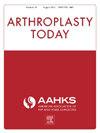单铰刀技术是初次全髋关节置换术中髋臼准备的有效策略
IF 2.1
Q3 ORTHOPEDICS
引用次数: 0
摘要
背景有效的髋臼准备是初次全髋关节置换术(THA)的关键步骤。大多数技术从一个小扩眼器开始,随后使用多个更大的扩眼器,直到达到所需的尺寸。我们通过评估组件的成功率,并通过报告任何术中并发症来确定其安全性,报告了一种更有效的单铰刀技术的有效性。方法回顾性分析2019年10月至2023年5月期间由2名奖学金培训的外科医生在透视引导下通过直接前路行原发性选择性tha手术的病例。我们的入选标准是使用单扩眼器技术和至少1年的随访。选择单个铰刀作为最大的铰刀,完全固定在原生髋臼内,在髋臼壁之间没有任何前后平移。结果回顾了836例tha的数据。96例(11%)髋臼明显畸形且不能有效使用单铰刀技术的患者被排除在外,剩下740例(89%)符合纳入标准。术中无髋臼骨折。假体周围关节感染翻修时取出1杯(0.1%)。在剩余的739个髋臼杯中,25个(3%)需要髋臼螺钉,而714个没有补充螺钉固定。总体而言,使用单铰刀技术植入的99.7%的髋臼假体在1年内获得了成功的x线骨整合。1杯(0.1%)未能实现影像学上的骨长入,但有稳定的纤维固定,不需要翻修。结论:在髋臼形态正常的髋臼的结构化工作流程中,单铰刀技术是一种有效且安全的髋臼准备方法。本文章由计算机程序翻译,如有差异,请以英文原文为准。
A Single-Reamer Technique is an Effective Strategy for Acetabular Preparation in Primary Total Hip Arthroplasty
Background
Effective acetabular preparation is a critical step of primary total hip arthroplasty (THA). Most techniques begin with a small reamer and subsequently utilize multiple larger reamers until the desired size is achieved. We reported the effectiveness of a more efficient, single-reamer technique by evaluating component success rates and determining its safety by reporting any intraoperative complications.
Methods
All primary, elective THAs performed through a direct anterior approach using fluoroscopic guidance by 2 fellowship-trained surgeons between October 2019 and May 2023 were retrospectively reviewed. Our inclusion criterion was use of a single-reamer technique and minimum 1-year follow-up. The single reamer was chosen as the largest one that fully seated in the native acetabulum without any anteroposterior translation between the walls.
Results
Data for 836 THAs were reviewed. Ninety-six hips (11%) with significant acetabular deformity where a single reamer technique could not be effectively used were excluded, leaving 740 (89%) that met the inclusion criteria. There were no intraoperative acetabular fractures. One (0.1%) cup was explanted during revision for periprosthetic joint infection. Of the 739 remaining cups, 25 (3%) required acetabular screws while 714 were placed without supplemental screw fixation. Overall, 99.7% of acetabular components implanted using a single-reamer technique achieved successful radiographic osseointegration at 1 year. One cup (0.1%) failed to achieve radiographic bony ingrowth yet has stable fibrous fixation that has not required revision.
Conclusions
When applied within a structured workflow to hips with normal acetabular morphology, a single-reamer technique is an effective and safe method for acetabular preparation.
求助全文
通过发布文献求助,成功后即可免费获取论文全文。
去求助
来源期刊

Arthroplasty Today
Medicine-Surgery
CiteScore
2.90
自引率
0.00%
发文量
258
审稿时长
40 weeks
期刊介绍:
Arthroplasty Today is a companion journal to the Journal of Arthroplasty. The journal Arthroplasty Today brings together the clinical and scientific foundations for joint replacement of the hip and knee in an open-access, online format. Arthroplasty Today solicits manuscripts of the highest quality from all areas of scientific endeavor that relate to joint replacement or the treatment of its complications, including those dealing with patient outcomes, economic and policy issues, prosthetic design, biomechanics, biomaterials, and biologic response to arthroplasty. The journal focuses on case reports. It is the purpose of Arthroplasty Today to present material to practicing orthopaedic surgeons that will keep them abreast of developments in the field, prove useful in the care of patients, and aid in understanding the scientific foundation of this subspecialty area of joint replacement. The international members of the Editorial Board provide a worldwide perspective for the journal''s area of interest. Their participation ensures that each issue of Arthroplasty Today provides the reader with timely, peer-reviewed articles of the highest quality.
 求助内容:
求助内容: 应助结果提醒方式:
应助结果提醒方式:


